
The Hepialidae are a family of insects in the lepidopteran order. Moths of this family are often referred to as swift moths or ghost moths.

Capusa senilis, the black-banded wedge-moth, is a moth of the family Geometridae. The species was first described by Francis Walker in 1857. It is found in the south-eastern quarter of Australia.
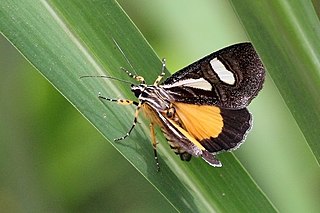
Agoma is a monotypic moth genus of the family Noctuidae erected by Sergius G. Kiriakoff in 1977. Its only species, Agoma trimenii, or Trimen's false tiger, was first described by Rudolf Felder in 1874. It is known from most countries of subtropical Africa.

Callioratis is a genus of moths in the family Geometridae.

Capusa is a genus of moths in the family Geometridae.

Dysphania is a genus of colourful moths in the family Geometridae and typical of the tribe Dysphaniini; they are sometimes called 'false tiger moths' and are found in northeast Australia, Melanesia, and south, east and southeast Asia.
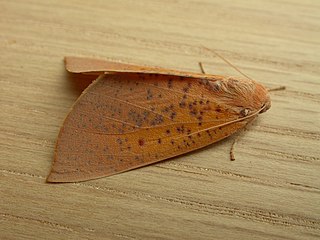
Plesanemma is a genus of moths in the family Geometridae erected by Peter B. McQuillan in 1984. Both species are found in Australia.

Pseudocoremia is a genus of moths in the family Geometridae erected by Arthur Gardiner Butler in 1877. This genus is endemic to New Zealand.

Sterrhinae is a large subfamily of geometer moths with some 3,000 described species, with more than half belonging to the taxonomically difficult, very diverse genera, Idaea and Scopula. This subfamily was described by Edward Meyrick in 1892. They are the most diverse in the tropics with the number of species decreasing with increasing latitude and elevation.

Synemon is a genus of moths within the family Castniidae. Edward Doubleday described it in 1846. The genus contains 24 described and 20 undescribed species. These species are found across mainland Australia and on Kangaroo Island, with the highest diversity in Western Australia. Synemon species can be found in a range of habitats, including woodlands, heathlands and native perennial grasslands. The adults fly during the daytime in warm to hot weather. They have clubbed antennae, and are often mistaken for butterflies.
Louis Beethoven Prout (1864–1943) was an English entomologist and musicologist.
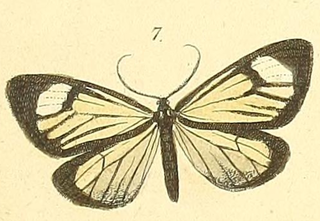
Monocreagra pheloides is a moth of the family Notodontidae first described by Cajetan and Rudolf Felder in 1874. It is found in Colombia, Ecuador and Peru.
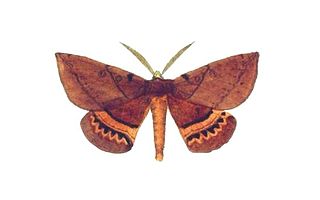
Chelepteryx chalepteryx, the white-stemmed wattle moth or white-stemmed acacia moth, is a moth of the family Anthelidae. The species was first described by Rudolf Felder in 1874. It is found in Australia.
Omphaliodes is a monotypic moth genus in the family Anthelidae described by Felder in 1874. Its only species, Omphaliodes obscura, described by Francis Walker in 1856, is found in Australia.
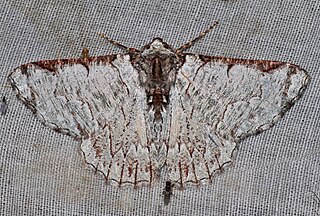
Lophophelma luteipes is a moth of the family Geometridae first described by Felder and Rogenhofer in 1875. It is found in China, the north-eastern Himalayas and Sundaland. The habitat consists of montane areas.

Microdes diplodonta is a moth in the family Geometridae. It is endemic to Australia, including Tasmania.
Hypomecis adamata is a moth of the family Geometridae first described by Felder in 1874. It is found in Sri Lanka.
Zamarada baliata is a moth of the family Geometridae first described by Felder in 1874. It is found in Sundaland and most likely in India and Sri Lanka.

Asaphodes obarata is a moth in the family Geometridae. It is endemic to New Zealand and has been collected in both the North and South Islands. It seems to inhabit the margins of native forest and also frequents plains, with an affinity for gorse hedges. The host plants of the larvae of this species are unknown. The adults are on the wing in December and January. It is classified as critically endangered by the Department of Conservation. There has been a contraction of range of A. obarata with it now being regarded as locally extinct in both Dunedin and Invercargill.
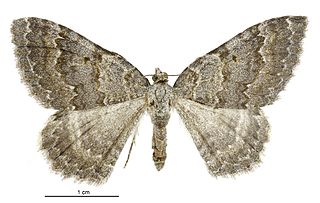
Gingidiobora subobscurata is a species of moth in the family Crambidae. It is endemic to New Zealand. This species has been classified as "At Risk, Declining" by the Department of Conservation.

















